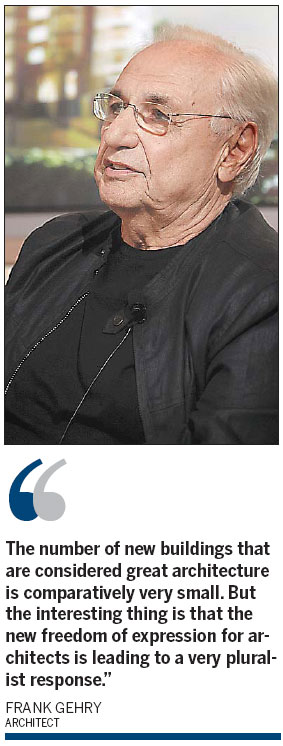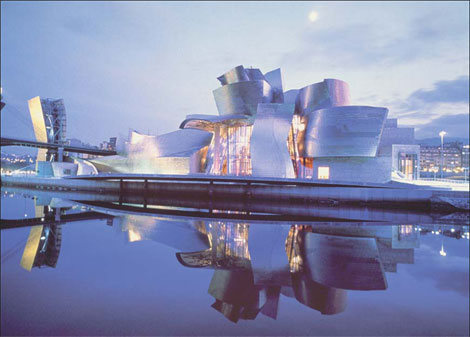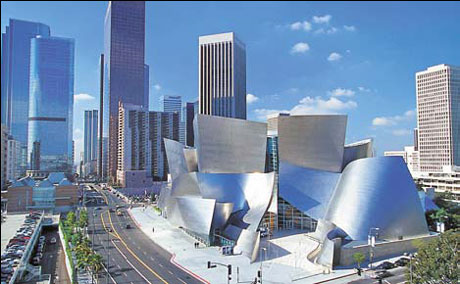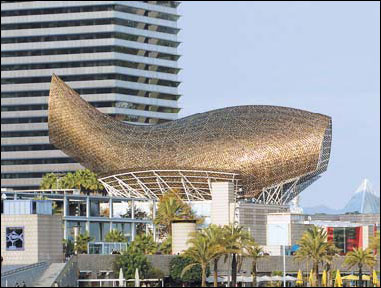Life and Leisure
Sculpted buildings
By Gan Tian (China Daily)
Updated: 2010-11-02 07:49
 |
Large Medium Small |
|
Frank Gehry's creations have changed the world's skyline, such as the Guggenheim Museum in Spain. Photos provided to China Daily |
|
The Walt Disney Concert Hall in Los Angeles. |
|
Vila Olimpica Fish Sculpture in Barcelona, Spain. |
Renowned architect Frank Gehry is happy designing the future, one building at a time. Gan Tian reports
Frank Gehry, the 1989 Laureate of the Pritzker Architecture Prize, is staging a solo exhibition in China for the first time. The exhibition, entitled Frank Gehry Architect, is being held at Sanlitun Village in Beijing. It features sketches, drawings, models, photographs and video clips, illustrating Gehry's creations around the world.
Visitors can discover stories behind buildings like the Guggenheim Museum in Bilbao, Spain, the Walt Disney Concert Hall in Los Angeles, the DZ Bank Building in Berlin, and the Serpentine Gallery Pavilion in London.
Unique is probably the best word to describe Gehry's works, according to Song Yang, editor of the Chinese edition of Mark Magazine.
"Anyone who sees Gehry's buildings will believe architecture is an art. I would prefer to say, they look like sculptures, rather than buildings," Song says.
"I hope the exhibition will inspire visitors as well as offer them a greater insight into how we work," Gehry said at the opening ceremony.
This was the Canadian-American architect's fourth time in the city. He said its ancient architecture is inspirational and informative for new work, but that its modern buildings seem more related to economics than architecture.
"The number of new buildings that are considered great architecture is comparatively very small. Not just here, everywhere in the world. But the interesting thing is that the new freedom of expression for architects is leading to a very pluralist response.
"When architects are given more opportunities, they make beautiful buildings, like Rem Koolhaas did for CCTV," he said.
While noting that Beijing has evolved from an ancient city into a modern one, he said its future urban development provides an example to the rest of the world.
"I hope it will do it right," he said.
Gehry's jewelry and furniture is also on display at the exhibition and the 81-year-old is still active and trying new things.
"I am also a sailor and I'm designing my own boat," he said.

Gehry also announced his first residential development in Asia, Swire Properties' 53 Stubbs Road in Hong Kong, which is due to be completed within two years.
The project is located on The Peak, and consists of only 12 residences in a single 12-story tower that has curving glass facades, supported by thin glass enclosed steel columns that bend like stalks of bamboo.
The architect expressed his wish that he could have more opportunities in China, which he believes is "dynamic, growing and optimistic".
"I am very excited at the prospect of sharing the evolution of my latest project in Hong Kong with the people of Beijing."
Gehry moved from Canada to Los Angeles at 17. After graduating from the University of Southern California's School of Architecture in 1954, he served in several companies in the following decades. In 1967, he opened his own firm Frank O. Gehry and Associates.
Gehry tried hard to get away from traditional architecture, experimenting with his own apartment. He loves Picasso, so visitors to his apartment will find the windows and fences around the house are made like elements in Picasso's paintings.
One day, a visitor asked him why he was so creative with his own home, but conservative elsewhere, which inspired him to be bolder with his designs.
His well-known works include the Schnabel Residence in Brentwood, California (1989), the Vitra Design Museum in Weil am Rheim, Germany (1989), the Chiat/Day Building in Venice, California (1991), and Vila Olimpica Fish Sculpture in Barcelona, Spain (1992).
There is always something mysterious and unexpected in Gehry's architecture. He uses corrugated metal, curved shapes and unusual surfaces.
"I have my own feelings about the world I'm living in," he said.
However, he said the architect should not play the role of a savior. "I don't presume to know where the world should go, or how the world should be," he said.
"When I was younger, I had visions of changing cities and doing great things. I think the reality is, architects like me have got to do one building at a time. We don't build the whole city. What we do is very trivial compared with the problems around us."
At present, he is completing design work on the Guggenheim Abu Dhabi Museum and the Foundation Louis Vuitton Museum in Paris.


